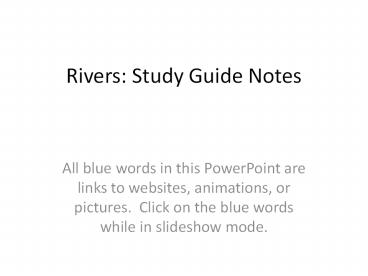Rivers: Study Guide Notes - PowerPoint PPT Presentation
1 / 7
Title:
Rivers: Study Guide Notes
Description:
Rivers: Study Guide Notes All blue words in this PowerPoint are links to websites, animations, or pictures. Click on the blue words while in show mode. – PowerPoint PPT presentation
Number of Views:195
Avg rating:3.0/5.0
Title: Rivers: Study Guide Notes
1
Rivers Study Guide Notes
- All blue words in this PowerPoint are links to
websites, animations, or pictures. Click on the
blue words while in slideshow mode.
2
River Formation
Rivers start from precipitation that begins to
flow downhill and forms surface runoff. Runoff
joins together to make small creeks and streams
that flow into larger rivers. All rivers flow
downhill, eventually leading to the ocean.
3
Parts of a River
- Tributary a small stream or river that flows
into a larger main river. - Source - the start of a river
- Mouth -the end of a river
- Gradient the change in elevation of a river.
(steepness of a river) The gradient always
decreases from the source to the mouth.
(Downhill)
4
- Meander - the bend of a river
- Inside bend (Point Bar) water slows down,
load (sediment) is deposited - Outside bend (Cut Bank) water speeds up, bend
gets curvier, rock is cut away - Floodplain - the area that floods when a river
overflows its banks.
5
River Erosion
- Discharge - amount of water flowing in a river.
- Load minerals, silt, weathered rocks, and sand
mixed into the water and flowing down the river.
Sometimes dissolved in (clear appearance) other
times a muddy appearance. - More Discharge More Erosion More Load
6
Where does the water go?
- Drainage Basins (Watersheds) The land drained
by a river system, which includes the main river
and all its tributaries. - All the water in a drainage basin drains to one
location. - Divide Separates drainage basins. It is an
area of higher ground than the basins that it
separates, like mountain ranges.
7
Changes to a River
- Young Rivers Flow fast, often over rapids and
waterfalls. They are usually narrow with steep
sides. - Old Rivers Wide with strong meanders and flow
smoothly and slowly through a flat area of land.
They are found in floodplains and often deposit
sediment along their banks or into deltas. - Why Rivers age Over time, the rocks that
cause rapids are eroded away. As rivers mature,
they reach level ground, the discharge slows, and
they begin to form meanders and even oxbow lakes.































